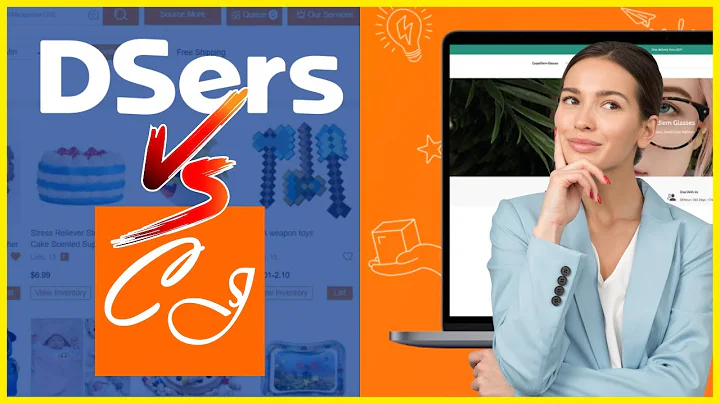10 Dropshipping Mistakes to Avoid
Table of Contents
- Introduction
- Mistake #1: Not Checking Shipping Times
- Mistake #2: Setting Unrealistic Goals
- Mistake #3: Starting with a Small Budget
- Mistake #4: Not Focusing on Viral Products that Solve Problems
- Mistake #5: Starting with a General Store Approach
- Mistake #6: Selling Copyright or Trademarked Products
- Mistake #7: Not Understanding Profit Margins
- Mistake #8: Using Debit Cards Instead of Credit Cards for Payments
- Mistake #9: Not Setting Up a Legal Business Entity
- Mistake #10: Not Staying Up to Date on Taxes and Bookkeeping
- Conclusion
Top 10 Mistakes You Need to Know Before You Start Dropshipping
Introduction
Hey guys, welcome back! Today, I want to share with you the top 10 mistakes that you need to know before you start dropshipping. These mistakes are crucial to avoid, as making just one of them can completely destroy your dropshipping business. I'll be sharing actionable tips that you'll be thankful for later. If this video reaches 4,000 likes, I will also release a document containing 10 viral winning products that are making thousands of dollars per day right now. So, don't forget to smash that like button and subscribe! Now, let's dive into the valuable information!
Mistake #1: Not Checking Shipping Times
One of the most common mistakes new dropshippers make is not checking the shipping times for the countries they are targeting with their advertisements. When sourcing products from AliExpress, it is important to carefully review the shipping options and times for each specific country. Different countries may have different shipping times, so finding the right supplier for each location is vital. For example, the United States may have a shipping time of 14 to 17 days, while Canada may take up to two months. Sending products with long shipping times can lead to unhappy customers, refund requests, and chargebacks, which can harm your business. It is crucial to be mindful of shipping times to ensure customer satisfaction and business success.
Mistake #2: Setting Unrealistic Goals
Many beginners in dropshipping have unrealistic expectations and believe it is a get-rich-quick scheme. They set lofty goals of making $50,000 or $100,000 within a few months. However, it is important to understand that dropshipping takes time and effort. As a beginner, it is unlikely that you will make money right away. Instead, focus on learning as much as you can about the business model. The initial hurdle of getting sales is often the hardest part. Once your store starts generating sales, you can ramp up your advertising efforts and scale your business. It is essential to have realistic expectations and embrace the learning process rather than expecting instant wealth.
Mistake #3: Starting with a Small Budget
One of the biggest Achilles' heels for newbies in dropshipping is starting with a small budget. While $100 or $200 may be enough to set up your first store, it may not be sufficient to sustain your business in the long run. It is advisable to start with a budget of at least $2,000 to $3,000 dedicated to testing different products. This allows for a higher likelihood of finding a winning product. If you don't have this amount of money yet, it may be better to secure a job first. Remember, turning $100 into $1,000 requires a 10x return, which can be challenging. Starting with a more substantial budget increases your chances of success and scalability.
Mistake #4: Not Focusing on Viral Products that Solve Problems
Another common mistake is not focusing on viral products that solve real-world problems. It is not uncommon for beginners to choose random trinkets, jewelry, or fashion products to sell. While these products can sell, they are highly competitive niches that may be harder to convince customers to buy. Instead, it is recommended to find products that fill a gap in the marketplace and provide a solution to a problem. For example, selling a knee brace that helps people with knee problems alleviate pain and walk better solves a real-world problem. Such products are much easier to sell as they appeal to a specific target audience with a genuine need. Focus on solving problems rather than selling random trinkets to increase your chances of success.
Mistake #5: Starting with a General Store Approach
The general store approach, which involves selling various products under one store, is a mistake that many beginners make. Instead of focusing on quantity, it is better to prioritize quality and merchandise fewer products effectively. Starting with a niche store or a one-product store allows you to dedicate more time to each product, creating compelling product descriptions, graphics, and effective Facebook ads. By narrowing down your focus to a specific niche or product, you can present your store as a reputable brand that offers solutions to a specific problem. This approach increases the likelihood of generating sales and establishing a strong brand image.
Mistake #6: Selling Copyright or Trademarked Products
Selling copyright or trademarked products can lead to severe consequences for your dropshipping business. Beginners often overlook this essential aspect and end up having their stores shut down. Companies hold the rights to their characters, brands, and logos, and if they file a report against you for selling their products without permission, Shopify will take down your website. Furthermore, you may face legal implications if you have been highly successful in selling copyrighted products. It is crucial to stay away from selling any products that include characters or references to other companies. Stick to original, non-infringing products to avoid legal trouble and protect your business.
Mistake #7: Not Understanding Profit Margins
Scaling a business without a clear understanding of profit margins can be detrimental. Many dropshippers make the mistake of not comprehending their actual net profit. It is crucial to track and measure your profit accurately by integrating apps like Lifetimely or Order Metrics into your store. These apps allow you to monitor real-time profits by integrating data from Facebook ads, Google ads, product costs, shipping costs, and fees. Knowing your exact profit margins enables you to make informed decisions about scaling your business. If you have a 30% profit margin, for example, you can allocate more money towards ads, increasing the likelihood of scaling successfully and maximizing your profits.
Mistake #8: Using Debit Cards Instead of Credit Cards for Payments
Using debit cards or personal bank accounts for business expenses can limit your opportunities to leverage credit card rewards. Although it is essential to pay off your credit card balances each month, using credit cards strategically can yield significant rewards for your e-commerce business. Certain credit cards offer cash-back rewards of three to four percent on marketing expenses, providing an opportunity to earn substantial rewards over time. By capitalizing on these rewards, you can potentially earn thousands of dollars each year, which can be used toward various business expenses or personal endeavors. If you are scaling your business, consider utilizing credit cards wisely to benefit from these rewards.
Mistake #9: Not Setting Up a Legal Business Entity
As your dropshipping business starts generating revenue, it becomes crucial to set up a legal business entity. Starting with a sole proprietorship may work initially, but as your business scales, you may find it more tax advantageous to establish an S Corporation or another type of legal entity. It is essential to consult with certified tax professionals or local CPAs to determine the most suitable business structure for your specific circumstances. Setting up a legal business entity offers tax benefits and can help protect your personal assets in case of unforeseen circumstances. Take this step once your business generates sales to optimize your long-term financial situation.
Mistake #10: Not Staying Up to Date on Taxes and Bookkeeping
Failing to stay up to date on bookkeeping and taxes can lead to serious consequences for your dropshipping business. Many beginners overlook the importance of proper bookkeeping until it becomes a stressful last-minute task at tax time. To avoid this, make sure to maintain accurate and up-to-date books throughout the year. Tools like QuickBooks can be helpful in automating this process, allowing for easy importation of bank transactions and simplifying the calculation of profits. By keeping your books in order, you can provide a clean profit and loss statement to your accountant, making the tax-filing process smoother. Stay on top of your financial records to ensure compliance and peace of mind.
Conclusion
In conclusion, being aware of and avoiding these top 10 mistakes can significantly increase your chances of success in the dropshipping business. Take the time to research, plan, and strategize before starting your venture. Remember, dropshipping is not an instant path to riches but a learning process that requires effort and dedication. Set realistic goals, stay up to date on best practices, and continuously educate yourself to adapt to the ever-changing e-commerce landscape. By avoiding these common pitfalls, you can build a thriving dropshipping business that generates consistent profits and customer satisfaction.
Highlights:
- Checking shipping times is crucial to avoid unhappy customers and chargebacks.
- Setting realistic goals and having patience is vital for long-term success.
- Starting with an adequate budget increases the likelihood of finding winning products.
- Focusing on viral products that solve problems is more effective than selling random trinkets.
- A niche or one-product store approach allows for better merchandising and brand credibility.
- Avoid selling copyright or trademarked products to protect your business from legal consequences.
- Understanding profit margins helps make informed decisions about scaling your business.
- Utilizing credit cards strategically can earn substantial rewards for your business.
- Setting up a legal business entity offers tax advantages and asset protection.
- Staying up to date on bookkeeping and taxes is crucial for compliance and peace of mind.
FAQs:
Q: How long should I expect shipping times to be for different countries?
A: Shipping times vary depending on the supplier and the country. It is important to check the specific shipping times for each country you are targeting to ensure customer satisfaction. Avoid long shipping times that may lead to customer dissatisfaction.
Q: What is the difference between a niche store and a general store?
A: A niche store focuses on a specific market or product category, allowing for better branding and targeting. A general store, on the other hand, sells a wide range of products, which can make it challenging to effectively merchandise and target customers.
Q: Can I sell products with famous characters or logos on my store?
A: It is advisable to avoid selling products with copyrighted or trademarked characters, logos, or brands. Selling such products can lead to legal consequences and the shutdown of your store. Stick to original, non-infringing products to protect your business.
Q: How much money should I start with for dropshipping?
A: It is recommended to start with a budget of at least $2,000 to $3,000 dedicated to testing different products. Starting with a larger budget increases your chances of finding a winning product and scaling your business successfully.


















